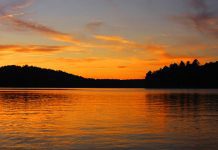While we don’t have mountains and beaches here in Middle Tennessee, we still have beautiful landmarks to brag about. Our area is home to many lakes and waterfalls that stretch into the Cumberland plateaus. They provide tranquility, recreation and gorgeous scenery.
Here are some of the most spectacular natural wonders you can explore in Middle Tennessee:
20 Natural Wonders In Middle Tennessee
1. Rock Island State Park
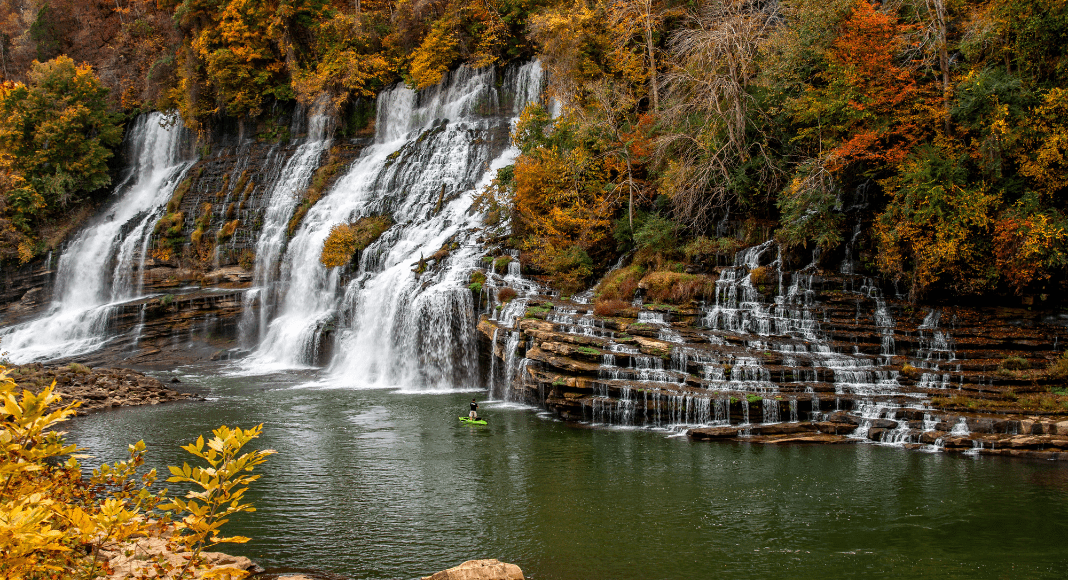
Rock Island State Park is a state park in Warren County and White County, Tennessee, located on the border of Middle/East Tennessee. The park is named after the community of Rock Island, Tennessee. Rock Island State Park is centered on a peninsula created by the confluence of two rivers (Caney Fork and Collins) and extends downstream to the headwaters of Center Hill Lake. Known for its rugged beauty and impressive waterfalls, the park includes the Caney Fork River Gorge (the gorge), one of Tennessee’s many national treasures. The gorge is a popular location for hiking and swimming offering deep-blue pools, scenic trails, and cascades—including Great Falls, a 30-foot waterfall located below the 19th-century cotton textile mill that it powered more than 100 years ago.
*While the Caney Fork River Gorge is an incredible display of Tennessee’s natural beauty, it’s vital that visitors understand the risks associated with entering the gorge. Please review the park’s safety information prior to visiting.
2. Old Stone Fort State Archeological Park
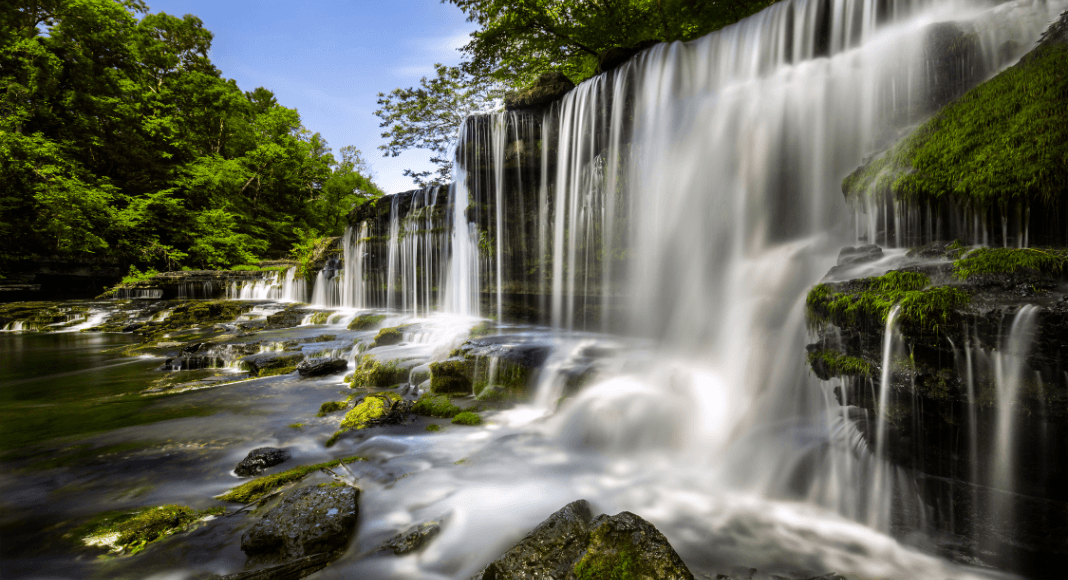
The Old Stone Fort was built during the Middle Woodland Period, 1,500-2,000 years ago. Native Americans used this area continuously for about 500 years, eventually leaving it abandoned. By the time European settlers arrived, it was unclear of what the area had been used for which resulted in it being misnamed as a fort. The park is home to an abundance of activities for guests to enjoy. The main hiking trail follows the wall of Old Stone Fort which was used by the Native Americans as a ceremonial gathering place. The trail threads through dramatic scenery where you can see the original entrance of the fort which was designed to face the exact spot on the horizon where the sun rises during the summer solstice. Visitors can learn about the Old Stone Fort on this hike with twelve interpretive panels as well as enjoying the areas graceful waterfalls.
3. Edgar Evins State Park
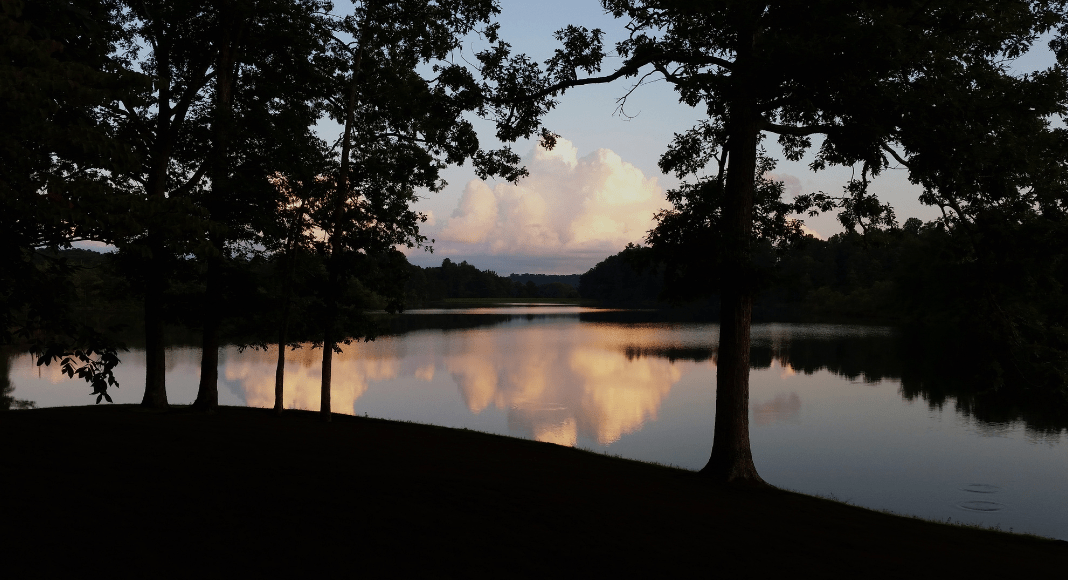
Edgar Evins State Park is located on the shores of Center Hill Lake in the steep, hilly Eastern Highland Rim, on the border of Middle/East Tennessee. The 6,000-acre park provides many recreational opportunities, cabins, and campsites on one of the most beautiful reservoirs in Tennessee. The park also has a large on-site marina with a restaurant and gift shop. Wildlife is abundant and includes three different owl species, numerous hawks, and wintering bald eagles as well as the rare Cerulean Warbler, a summer resident of the park’s mixed hardwood forests, which include stands of Tulip Poplar, Oak, Hickory, Buckeye, and Wild Cherry. An observation tower at the Visitor Center offers a spectacular view of Center Hill Lake and the surrounding hillsides.
4. Cumberland Caverns
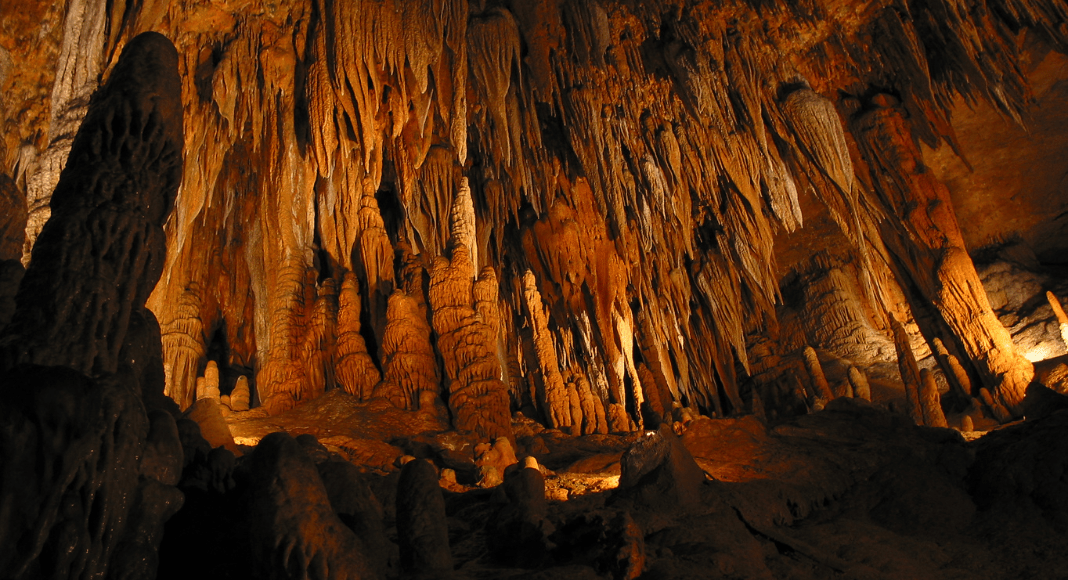
Cumberland Caverns is known far and wide as a place many first fall in love with caves and the hobby of caving. With almost 30 miles of caves and underground passageways, incredible underground rock formations, beautiful underground waterfalls, and gleaming pools, there is plenty of fun and adventure for everyone! They are open 7 days/week with tours departing at various times throughout the day. All tours are guided, reservations are recommended. They have a variety of walking tours, 4 different Caving Adventure Tours & 4 different Overnight Caving Adventure packages, and they also host Cumberland Caverns Live music events from 333 feet below. It is the longest show cave in Tennessee and makes the list of longest caves in the United States and the world.
5. Cummins Falls State Park
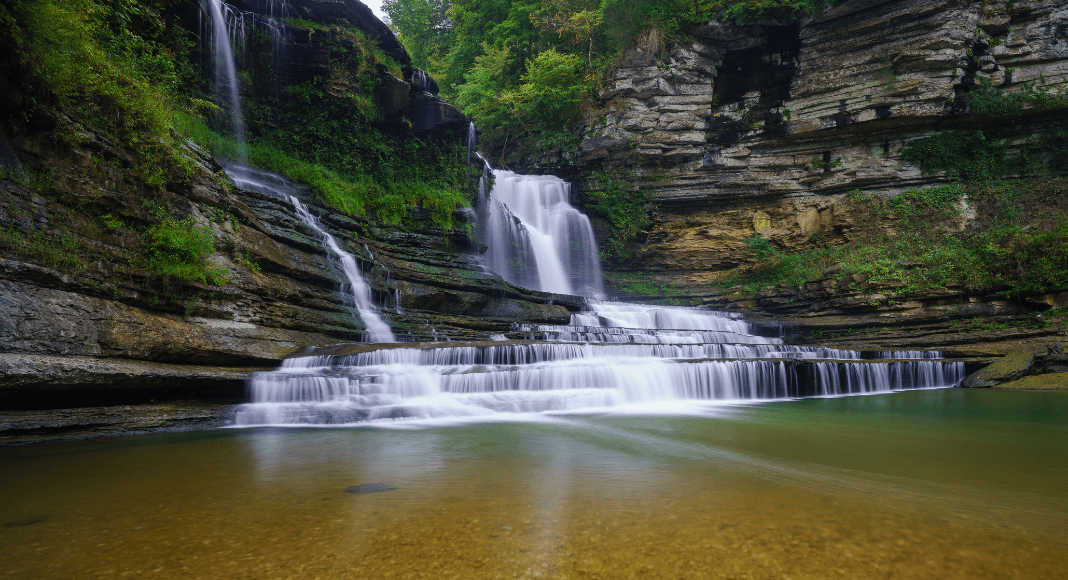
Cummins Falls State Park is a 306-acre day-use park located nine miles north of Cookeville on the Blackburn Fork State Scenic River on the Eastern Highland Rim. Located in the Cordell Hull Watershed, the area has been a scenic spot and swimming hole for local residents of Jackson and Putnam counties for more than 100 years. Cummins Falls is Tennessee’s eighth largest waterfall in volume of water and is 75 feet high. Cummins Falls also has been listed as one of the ten best swimming holes in the United States by Travel Leisure and Conde Naste magazines.
6. Land Between the Lakes
As part of America’s great outdoors since 1963, Land Between the Lakes National Recreation Area manages over 170,000 acres of forests, wetlands, and open lands on a peninsula between Kentucky and Barkley lakes in Western Kentucky and Tennessee. The family friendly recreation area offers one of the largest blocks of undeveloped forest in the eastern United States. With 300 miles of natural shoreline, lake access provides idyllic settings for camping, picnicking, hiking, fishing, boating, wildlife viewing, and water sports. Licensed hunts for deer, turkey, squirrel and other small game animals occur throughout the year.
7. Natchez Trace Parkway
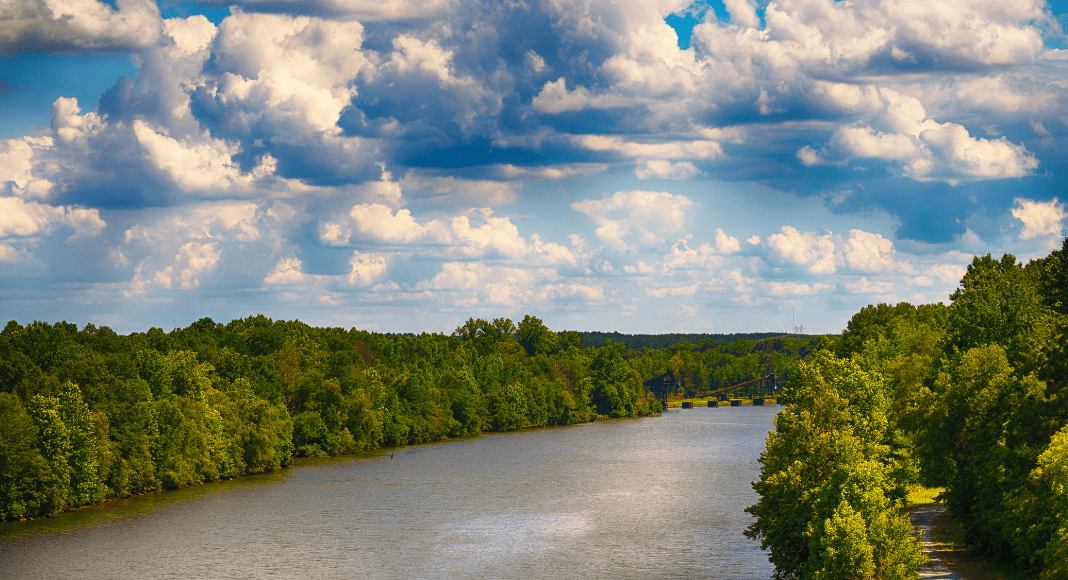
The Natchez Trace Parkway is a 444-mile recreational road and scenic drive through three states. It roughly follows the “Old Natchez Trace” a historic travel corridor used by American Indians, “Kaintucks,” European settlers, slave traders, soldiers, and future presidents. Today, people can enjoy not only a scenic drive but also hiking, biking, horseback riding, and camping along the Parkway. One of the most popular stops in Tennessee is Jackson Falls. Jackson Falls has a large parking area, bathroom facility, picnic area and a hiking trail. From the parking area next to the bathroom facility and picnic area hiking north 1/4 mile takes you to a viewpoint 300 feet above the Duck River and another 1/2 mile to the Baker Bluff Overlook site.
8. David Crockett State Park
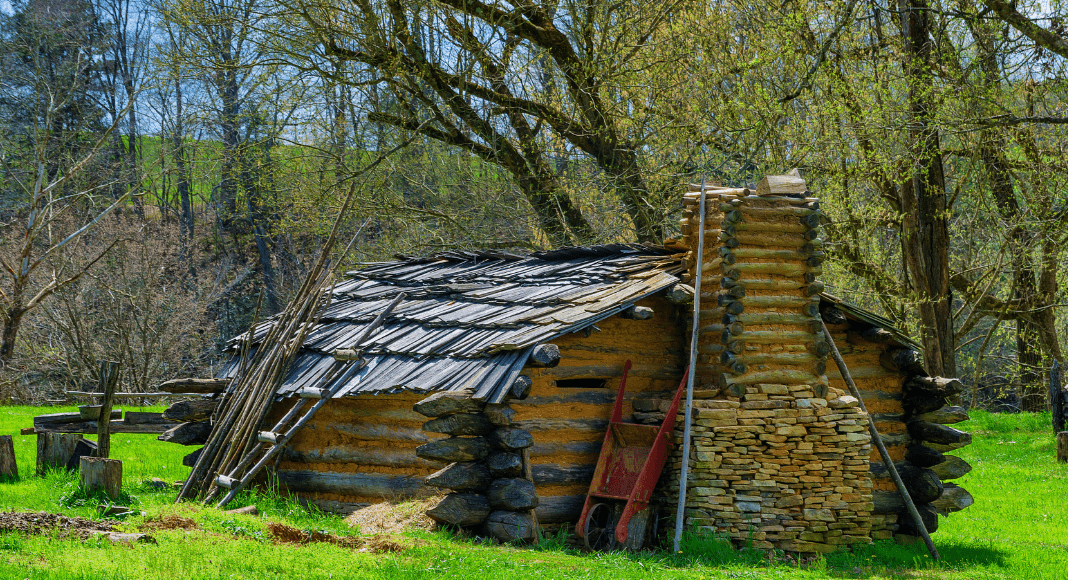
Along the banks of Shoal Creek, David Crockett established a diversified industry consisting of a powdermill, a gristmill, and a distillery in what is now his namesake park. All three operations were washed away in a flood in September 1821. Crockett died at the Alamo Mission in March of 1836 while aiding the Texans fighting for independence from Mexico. The 1,319-acre park has a museum staffed during the summer months, with exhibits depicting Crockett’s life here and a water-powered grist mill. In addition to the paved bike trail, the park has more than ten miles of hiking trails. The trails offer scenic vistas of Shoal Creek and Crockett Falls, limestone bluffs, abundant wildlife, and serene forest. The Overlook Trail runs parallel to the Shoal Creek Trail. David Crockett State Park has seven cabins near beautiful Lake Lindsey.
9. Tims Ford State Park
Located on the Tims Ford Reservoir, the 3,546-acre Tims Ford State Park sits in the shadows of the Cumberland Plateau in south-central Tennessee. The Tims Ford Lake is considered one of the most picturesque lakes in Tennessee and is regarded as one of the top bass fishing and recreational lakes in the Southeast. Another popular activity is golfing. The park is home to the Bear Trace at Tims Ford which is part of the Jack Nicklaus-designed collection. The Tims Ford Reservoir is visible from most holes on the course and comes into play on several of the 18 holes, giving the course an excellent balance of challenge and playability.
10. Radnor Lake State Park
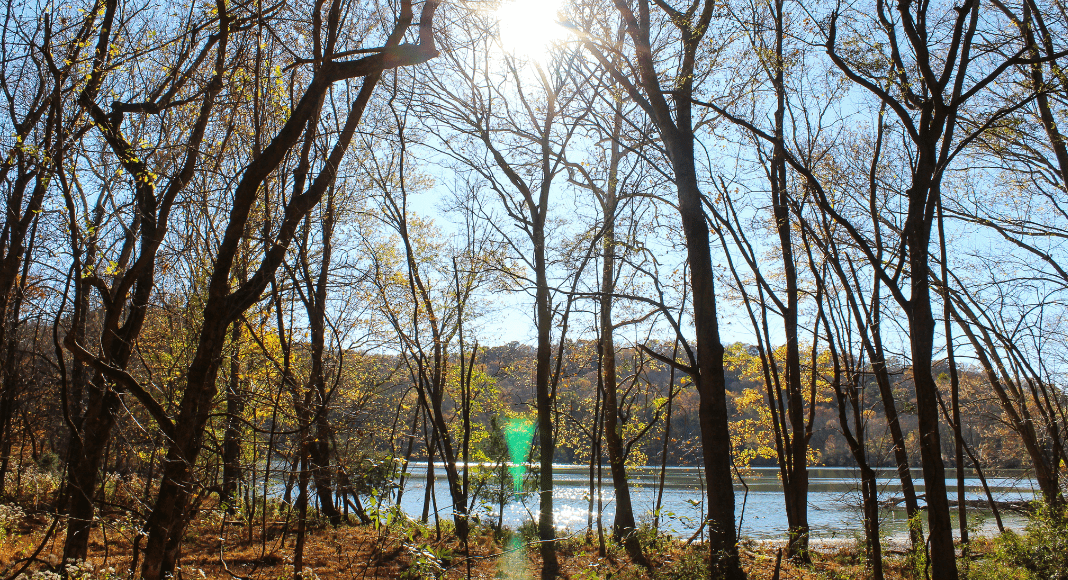
Radnor Lake State Park is a 1,368-acre park and is protected as a Class II Natural Area. It is unique due to the abundance of wildlife viewing opportunities, environmental education programs, hiking opportunities, and its location in an urban area. The park is perfect for nature enthusiasts to observe owls, herons, and waterfowl as well as many species of amphibians, reptiles, and mammals such as mink and otter. Hundreds of species of wildflowers, mosses, fungi, ferns, and other plants, as well as trees, shrubs, and vines, add to the natural ecological diversity of the area. Several ranger-led programs are planned throughout the year including canoe floats, wildflower walks, astronomy night hikes, nature hikes, programs on snakes, off-trail land acquisition hikes, and birds of prey.
11. Port Royal State Historic Park
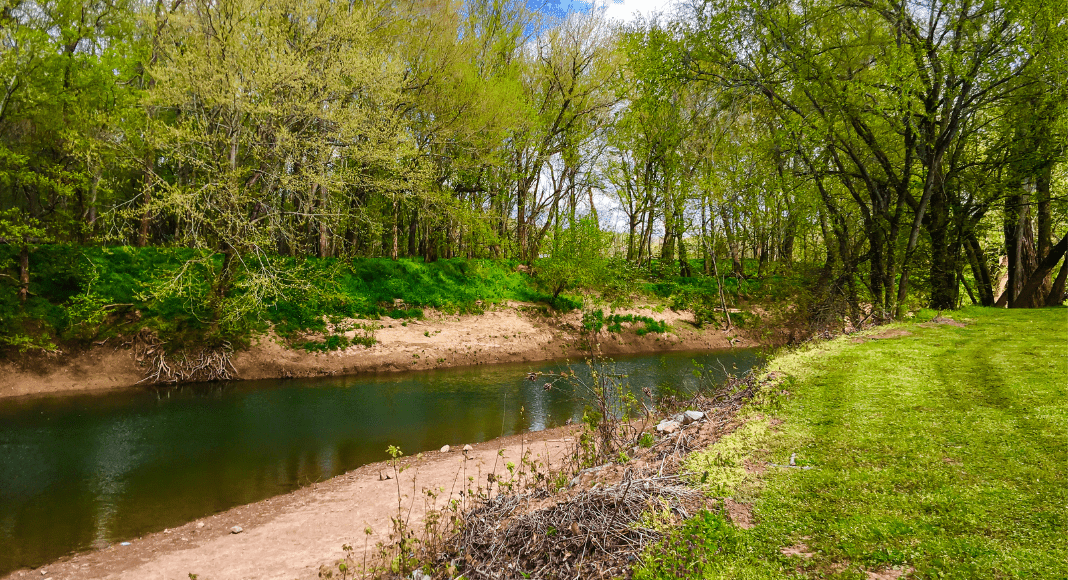
Port Royal State Historic Park is small, but it holds a large story. The town of Port Royal was established in 1797, one year after Tennessee Statehood. The creation of a tobacco inspection point and flatboat yard led to the town’s role as a regional tobacco town—one that relied on dark fired tobacco as currency and saw flatboats leave down the Red River to New Orleans by the dozens every year. The park is 30 acres and is located in Adams, Tennessee. What began as a small flatboat port eventually saw the construction of a Silk Mill (the only in Tennessee), general stores, tailors’ shops, inns, taverns, churches and warehouses. A thriving community! In 1838, over 10,000 Cherokee slept in the State of Tennessee for the last time at Port Royal. Today Port Royal is part of the National Trail of Tears Historic Trail. Port Royal’s story is complicated. It’s the story of enslaved men, women, and children. It is the story of the Cherokee. It is the story of agriculture and commerce. It is a series of connected moments that unveil the story of Tennessee. Come visit , and connect with something bigger than yourself.
12. Percy Priest Lake
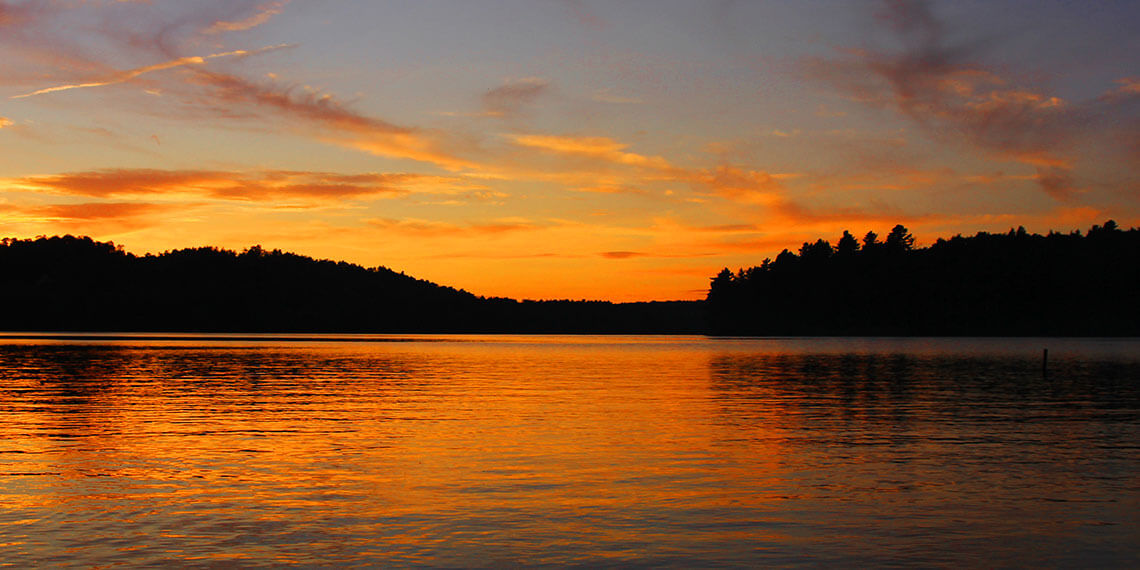 Located in the north central region of Tennessee, J. Percy Priest Lake lays between the sixth and seventh mile of the Stones River. The dam is located about 10 miles east of Nashville, which is the state capital. Covering portions of Davidson, Wilson and Rutherford counties, the lake measures 42 miles long. It spans across 14,200 acres. An entire town, known as Old Jefferson, was flooded by the lake. The town was demolished when the dam was under construction in the early 1960s. Of the 18,854 acres surrounding the lake, some 10,000 acres are devoted to wildlife management. The Corps of Engineers’ Nashville District personnel supervise and operate the powerhouse, dam, public lands and lake. The Natural Resource Management Office maintains 11 picnic areas, three campgrounds and 12 boat ramps. There are several marinas serving the lake as well. Several recreational organizations, including Vanderbilt Sailing Club, Vanderbilt Rowing Club, Nashville Rowing Club, Percy Priest Yacht Club and Tennessee Boat Club call the lake their home. It is a great place for camping, boating, and playing on the shore sands.
Located in the north central region of Tennessee, J. Percy Priest Lake lays between the sixth and seventh mile of the Stones River. The dam is located about 10 miles east of Nashville, which is the state capital. Covering portions of Davidson, Wilson and Rutherford counties, the lake measures 42 miles long. It spans across 14,200 acres. An entire town, known as Old Jefferson, was flooded by the lake. The town was demolished when the dam was under construction in the early 1960s. Of the 18,854 acres surrounding the lake, some 10,000 acres are devoted to wildlife management. The Corps of Engineers’ Nashville District personnel supervise and operate the powerhouse, dam, public lands and lake. The Natural Resource Management Office maintains 11 picnic areas, three campgrounds and 12 boat ramps. There are several marinas serving the lake as well. Several recreational organizations, including Vanderbilt Sailing Club, Vanderbilt Rowing Club, Nashville Rowing Club, Percy Priest Yacht Club and Tennessee Boat Club call the lake their home. It is a great place for camping, boating, and playing on the shore sands.
13. Montgomery Bell State Park
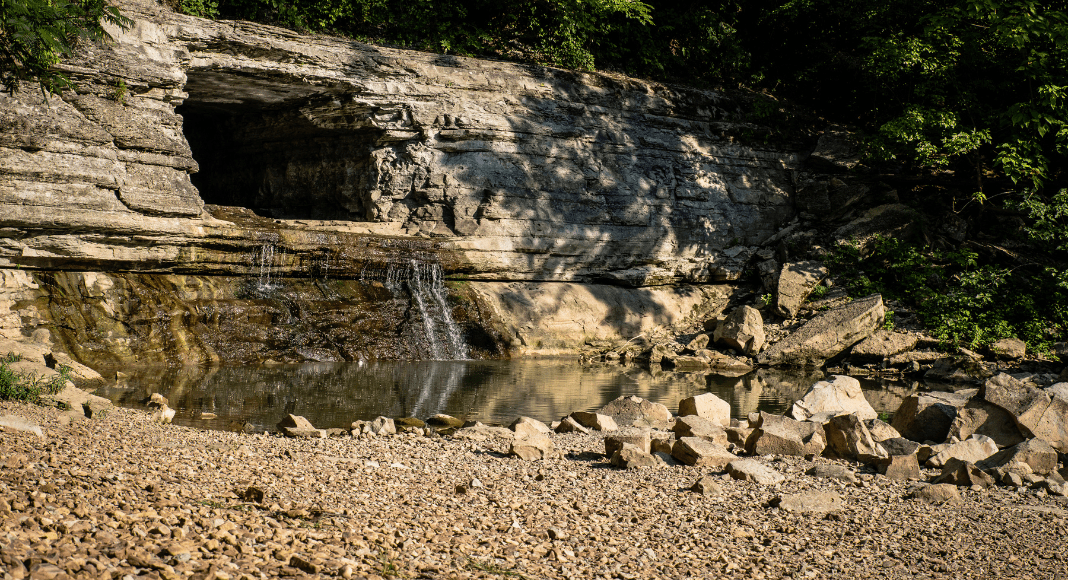
Montgomery Bell State Park is located only 40 minutes from downtown Nashville in Dickson County. Three lakes are nestled into the 3,850-acre park and provide visitors the opportunity to soak up the sun on their swim beach shores and paddle the calm waters. The park was once the center of the iron industry in Middle Tennessee. The park’s namesake, Montgomery Bell, formed one of the largest iron industries in Tennessee. Iron was once thought to be more valuable than gold and was a very lucrative industry at the time. Visitors can experience a natural retreat at the newly renovated Lodge inside Montgomery Bell. The fully remodeled 117-room Lodge sits on the banks of Lake Acorn and provides guests with the opportunity to escape to peace and quiet while being just minutes away from the interstate. The renovated Lodge features modern rooms, a new full-service restaurant and bar open to park visitors. Group Camp One was built in the 1930s by the Civilian Conservation Corps and is considered a historic landmark. The buildings are constructed of hand-hewn stone. The 47 rustic cabins, which do not have air conditioning or heating, sleep 120 people. The site of the first Cumberland Presbyterian Church is also located at Montgomery Bell State Park. The church was founded in 1810 in the log cabin home of Reverend Samuel McAdow. A replica of the cabin and a church are within the park.
14. Burgess Falls State Park and Natural Area
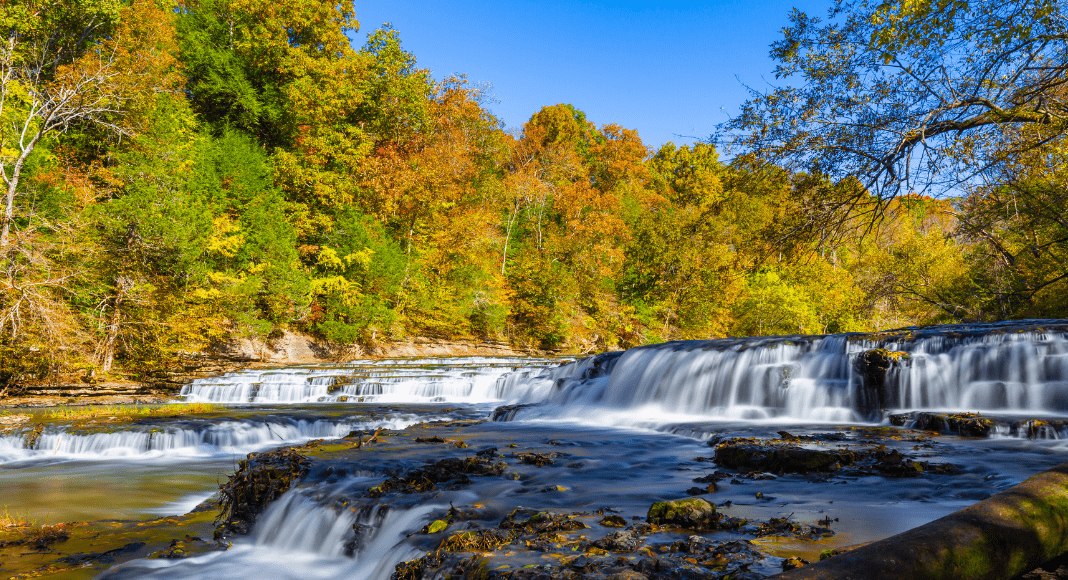
Located on the Falling Water River, this day-use park is noted for its natural beauty and four waterfalls that cascade down from over 250 feet in elevation. The last of these falls is the most spectacular, plunging more than 130 feet into the gorge. The area was originally populated by Native Americans of the Cherokee, Creek and Chickasaw tribes. These tribes used the land as a hunting ground until the late 19th century when a gristmill and sawmill began operating on the river. The Falling Water River was used to generate hydroelectric power for the city of Cookeville from 1928-1944. In 1973, the territory became a designated Tennessee State Natural Area, protecting the diverse forest and aquatic habitats.
15. Short Springs Natural Area
Short Springs is a 420-acre natural area located in Coffee County approximately three and a half miles northeast of Tullahoma. The natural area provides an excellent contrast between Highland Rim and Central Basin geology and vegetation. When descending along the Machine Falls trail, a visitor can observe exposed black Chattanooga shale at mid-slope, which is a formation that delineates the Central Basin from the Highland Rim. Thickets of mountain laurel grow on the upper slopes under a dry oak-hickory forest canopy that is characteristic of Highland Rim vegetation. The lower slopes and riparian areas along Bobo Creek support towering sycamore, buckeye, magnolia, beech, and tulip poplar trees with a rich shrub layer and herbaceous cover. Short Springs is one of the very best spring wildflower locations in the state. In the spring, moist slopes are covered in trout lilies, Virginia bluebells, jack-in-the-pulpit, larkspur, and Dutchman’s breeches. Large flowered trillium (Trillium grandiflora), southern red trillium (Trillium sulcatum), and barren strawberry (Waldsteinia fragarioides) are uncommon plants for Middle Tennessee that occur here. The natural area also supports two state-listed endangered plant species, Nestronia (Nestronia umbellula) and broad-leaved bunchflower (Melanthium latifolium)
16. Bell Witch Cave
A 40-minute drive from Nashville, The Historic Bell Witch Cave is located in a secluded area in Adams, Tennessee and is a very beautiful representation of Tennessee with its rolling green hills and farm land. The Bell Witch Cave is associated with the true story of the Bell Witch and considered to be one of the most haunted places in America. This property and the cave were once owned by John Bell. This is the very land that the Bell Witch tormented the Bell family on in the early 1800’s. You can explore the cave and learn about the Bell Witch haunting. Canoe trips are also available 6 days a week, May through the last week in September.
17. Stillhouse Hollow Falls State Natural Area
Stillhouse Hollow Falls is a 90-acre state natural area named for its most significant feature, 75-feet Stillhouse Hollow Falls. It is located approximately 21 miles southwest of Columbia in Maury County. The natural area is on the Western Highland Rim in the Duck River watershed. The geology of this region creates scenic natural features such as seeps, flat shale-bottom streams, and waterfalls, both small and large, which help shape the region’s dissected topography. The main falls can be seen by walking approximately 2/3 of a mile along the trail. The trail crosses an unnamed tributary that forms small scenic cascades before plunging approximately 75 feet over the falls. A deep hollow is formed below the falls that is surrounded by steep slopes where wet-weather springs emerge contributing to a rich habitat supporting a colorful spring wildflower display of trillium, spiderwort, wild geranium, phlox and many other species. Stillhouse Hollow Falls was designated a state natural area in 2006 and is protected in perpetuity under the Natural Areas Preservation Act of 1971.
18. Virgin Falls State Natural Area
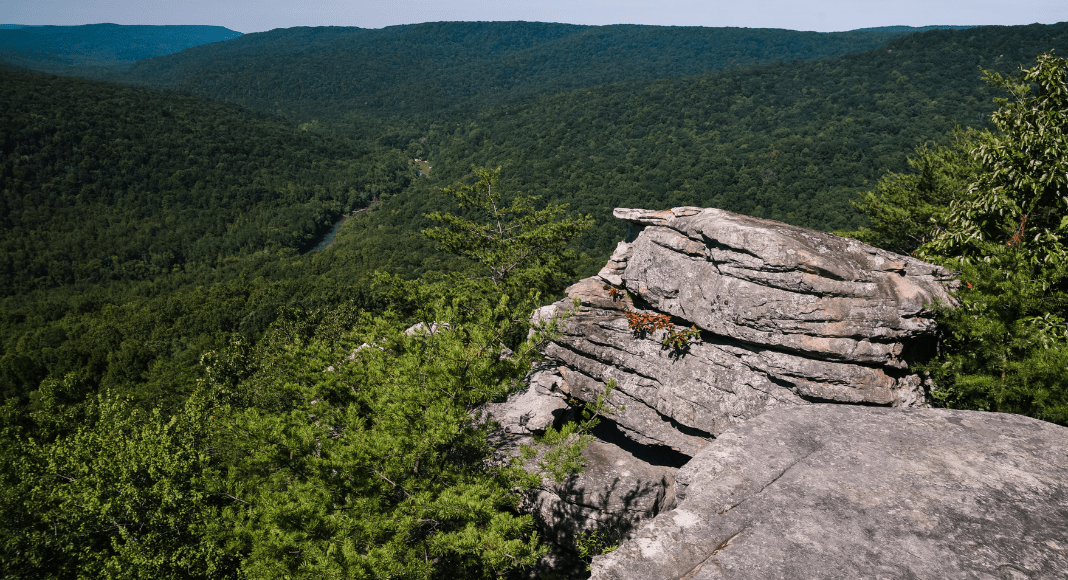
Virgin Falls is 1,157-acre natural area located in Sparta in White County. The natural area is named for Virgin Falls, which is formed by an underground stream that emerges from a cave, then drops over a 110-foot high cliff before disappearing into another cave at the bottom of the sink. The area is noted for its unique geological features and several (additional) other waterfalls including Big Laurel, Sheep Cave Falls, and Big Branch Falls. There are several notable caves in the area, including the cave above Virgin Falls, where the stream itself that forms the falls issues. Due to white nose syndrome, all caves on the area are closed to recreational use. The sinkholes at Virgin Falls, such as Virgin Falls Sink and Sheep Cave Sink, are characteristic of karst features found on the Cumberland Plateau. The Caney Fork River and its tributaries drain the area and contribute to the formation of the gorge. The Martha’s Pretty Point provides a dramatic view of Scott’s Gulf and the Caney Fork River 900 ft below.
19. Natural Bridge
Natural Bridge is a three-acre natural area located in Franklin County. Natural Bridge is a 25 feet high natural sandstone arch with a span of 50 feet that provides a scenic overlook of Lost Cove. There is a wet weather spring associated with a rock house located behind the natural bridge. The spring probably contributed to the formation of the arch. Lost Cove is a large karst formation on the dissected section of the Cumberland Plateau. It is essentially a giant sinkhole. Lost Creek flows into the valley and disappears into Lost Cove Cave at the Big Sinks and re-emerges as Crow Creek from Buggytop Cave within Mr. & Mrs. Harry Lee Carter State Natural Area. The site also has been referred to as Sewanee Natural Bridge since the University of the South in Sewanee once owned it. The natural area is a part of the South Cumberland Recreation Area.
20. South Cumberland State Park
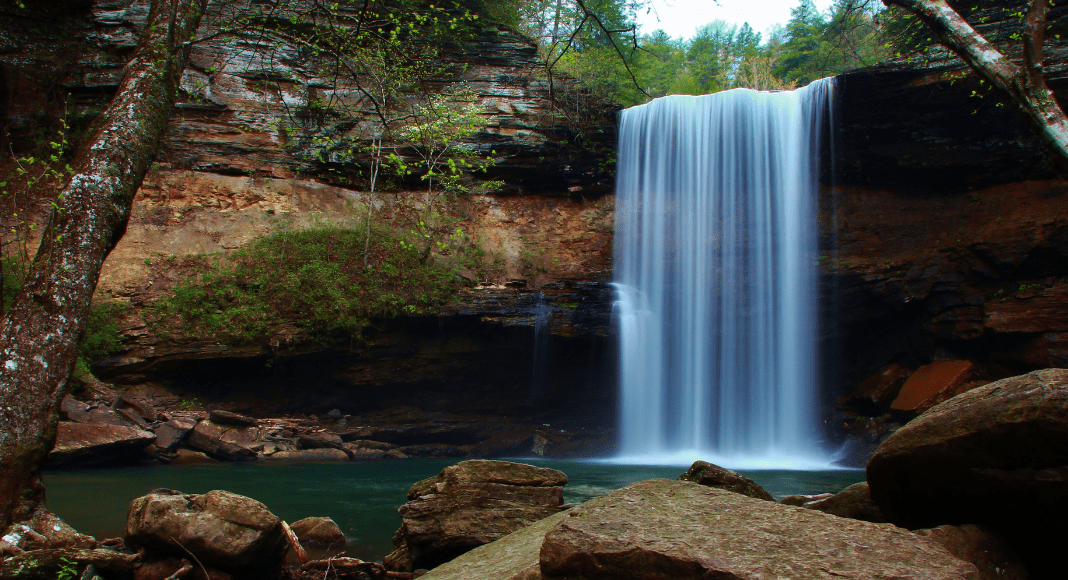
South Cumberland State Park is located within three different Tennessee counties: Grundy, Franklin, and Marion. The park is composed of approximately 12,166 acres and boasts some of the best hiking and backcountry camping in the region. There are lots of areas to explore including Fiery Gizzard, Denny Cove, Lost Cove, and Grundy Lakes. The Fiery Gizzard Trail at South Cumberland State Park is a 12.5-mile-long one-way trail that connects the Grundy Forest and Foster Falls. Hikers may swim in Fiery Gizzard Creek and observe spectacular rock formations, cascading streams, waterfalls, rocky gorges, panoramic overlooks, and lush woodlands. This trail has been rated by Backpacker magazine as one of the Top 25 in the country and should not be missed! Carter Natural Area is part of a unique 18,000-acre enclosed valley sinkhole aptly named Lost Cove. Dense forests, clear streams, and the striking Buggytop Cave entrance (one of the largest cave openings in the state) are a few of the features found here.











